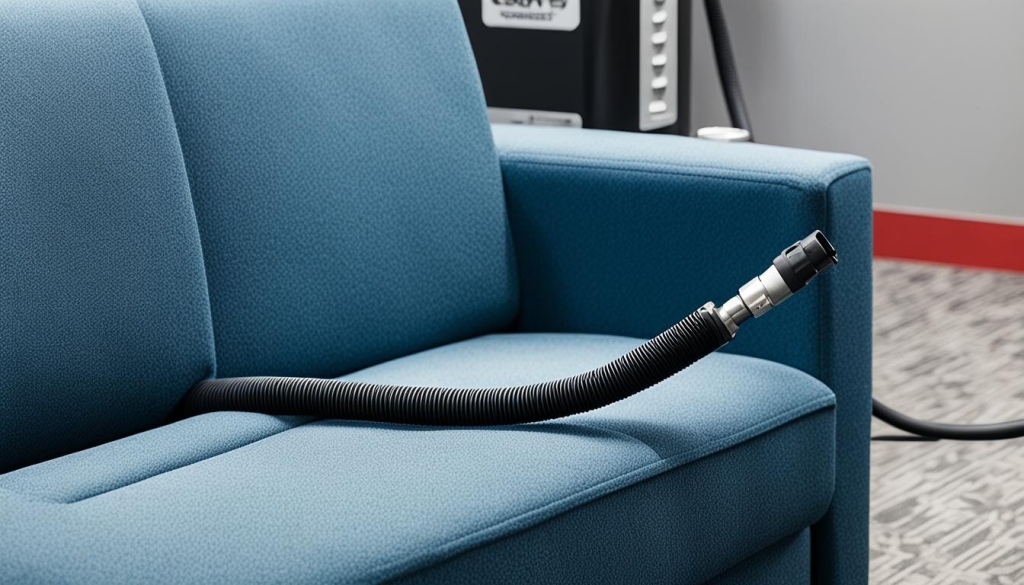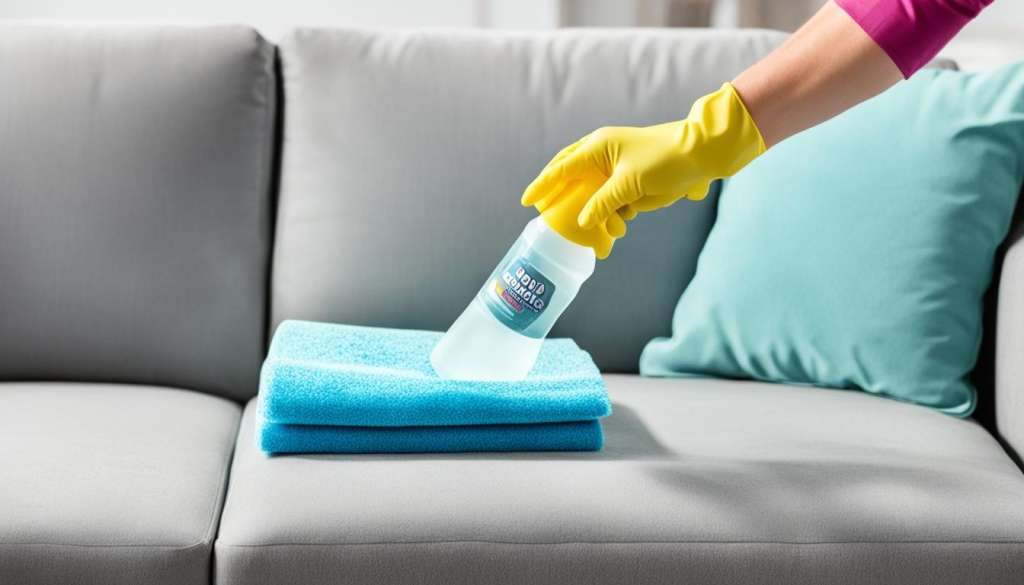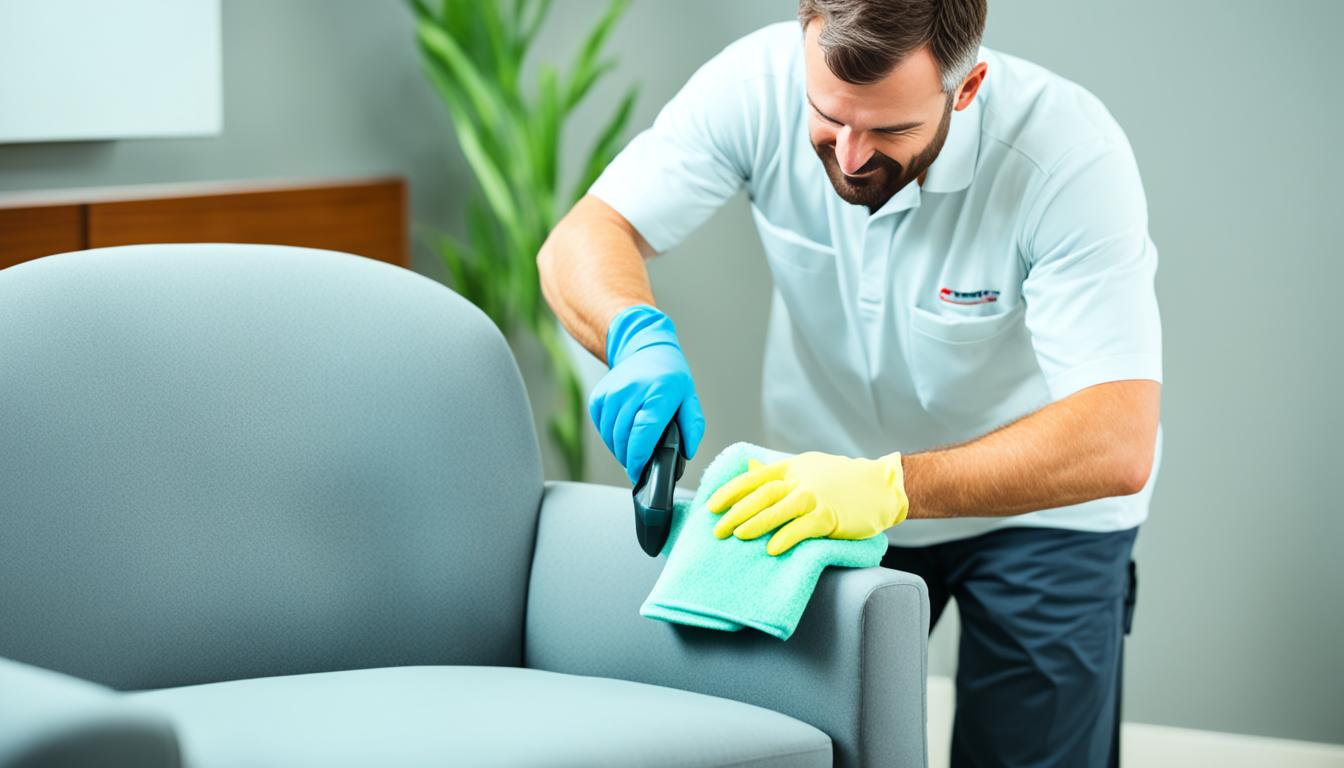When thinking about upholstery cleaning methods, it’s vital to balance the benefits of cleaning against the costs. Also, keeping your upholstery in good shape isn’t just about looks – it’s also about staying healthy and making things last longer. So, finding out how often to clean your upholstery is pretty essential.
Key Takeaways
- Recognize the substantial amount of indoor dirt residing within upholstered furniture.
- Decipher the DIY vs. Professional Upholstery Cleaning debate for your home’s needs.
- Evaluate the overall upholstery cleaning benefits for a healthier living space.
- Weigh the upholstery cleaning cost comparison to make an informed decision.
- Consider the upholstery fabric maintenance to prolong the life of your furniture.
- Understand the recommended upholstery cleaning frequency to maintain optimal cleanliness and comfort.
- Analyze the pros and cons of upholstery cleaning for both DIY and professional approaches.
The Importance of Upholstery Cleanliness
Keeping your furniture clean does more than just make it look good. It’s also key to a healthy home environment. Learning about upholstery care and maintenance can make your furniture last longer and improve your health. Let’s see how regular cleaning can improve your home and life.
Understanding Upholstery Care and Maintenance
Upholstered furniture makes a house feel like home. It adds comfort and style to our living spaces. But dust, allergens, and spills can damage its beauty and condition.
Regular upholstery maintenance is vital to keeping furniture looking great. This prevents early fabric aging and dust buildup. Following care instructions and performing things like vacuuming and occasional professional cleanings will protect your pieces.
The Impact of Regular Cleaning on Furniture Longevity
Cleaning your upholstery not only keeps it looking good but also makes it last longer. If you don’t, the fabric can be damaged beyond repair. Frequent cleaning is necessary.
You can avoid wear and tear by getting rid of dirt and oils. This way, your furniture can stay as the main attraction in your home for a long time.
Health Benefits of Clean Upholstery
Clean upholstery isn’t just about looks or lasting longer. It’s essential for a healthy home, too. Dirty furniture can hold dust mites, pet fur, pollen, and mold, which can cause allergies and breathing problems.
Keeping a clean house means you and your family can stay healthier. So, it’s worth it to follow a good cleaning schedule.
| Care Technique | Frequency | Benefits |
|---|---|---|
| Vacuuming | Weekly | Removes surface dirt and dust, prevents particle accumulation |
| Spot Cleaning | As spills occur | Addresses stains immediately to prevent setting |
| Professional Cleaning | Annually | Deep cleans and preserves fabric integrity |
DIY vs. Professional Upholstery Cleaning: What You Need to Know
Knowing the upholstery cleaning methods helps keep your furniture fresh and lasting longer. The DIY vs. Professional Upholstery Cleaning debate concerns costs and how well it works.

Considering DIY? Remember, rental machines might seem cheap, around $30, but they often miss a deep clean. The difference between these and professional gear is enormous. Pros have more substantial equipment, so they use more water without leaving things too wet, which can stop mildew.
How well cleaning works varies greatly. Consumer reports show big differences in the results of cleaning machines. Yet, professional services are usually better than DIY methods.
| Aspect | DIY Upholstery Cleaning | Professional Upholstery Cleaning |
|---|---|---|
| Equipment Used | Rental Machines | Advanced Suction Equipment |
| Cost | Around $30 (Rental) | Several Hundred Dollars |
| Risk of Mildew | Higher Risk | Lower Risk |
| Cleaning Effectiveness | Varies | Generally Better Results |
DIY might initially seem cheaper, but consider your furniture’s future and health. It’s key to look beyond just the cost. Checking upholstery cleaning comparison facts can help you choose between DIY and professional help.
Common Methods for DIY Upholstery Cleaning
DIY upholstery cleaning methods save money and let you choose your cleaning methods. It’s essential to know the fabric types and their cleaning needs. For instance, ‘WS’ means using a mild detergent with steam or dry cleaning, ‘S’ requires dry cleaning, and ‘X’ only needs vacuuming.
Natural cleaners are great for removing stains and smells. Baking soda can freshen up upholstery by absorbing odors. Mixing vinegar with water makes an effective spray to get rid of smells. Products like Nature’s Miracle are suitable for pet smells.
Always blot fresh spills quickly with an absorbent cloth to prevent them from sinking. A mix of vinegar, warm water, and dish soap for fabric upholstery works well. Use olive oil and vinegar for leather and a similar mix for synthetics, but adjust for their specific needs.
Upholstery cleaning solutions for DIY projects are affordable and effective. Here’s a table of DIY cleaners for different materials.
| Type of Upholstery | DIY Cleaning Solution | Method |
|---|---|---|
| Fabric | Vinegar, Warm Water, Dish Soap | Use a soft brush or cloth to apply |
| Leather | Olive Oil, Vinegar | Gently wipe and condition |
| Synthetic | Vinegar, Warm Water, Liquid Dish Soap | Apply with a cloth, avoiding saturation |
It is very important to dry upholstery well after cleaning. If possible, dab excess water with a clean towel and let it air dry. Use a box fan to dry it quickly without harming it in humid areas.
Regular maintenance is key, like using a lint roller for fabric and soap and conditioner for leather. Steam cleaning fabric can also help remove dirt and stains. Stick to customized DIY care to avoid common mistakes made by professional services.
Cleaning doesn’t stop at upholstery. Here are tips for other items around the house.
- Leather goods: Clean with specialized leather cleaner and protect with a conditioner.
- Wood furniture: Dust regularly and use specific wood-cleaning products.
- Laptops: Use compressed air and microfiber cloths to keep them dust-free.
- Footwear: Depending on the material, use appropriate brushes and cleaners.
Embracing these DIY cleaning methods can greatly improve your home’s overall environment.

What to Expect with Professional Upholstery Cleaning Services
Seeking professional upholstery cleaning services is brilliant for keeping your furniture in top shape. These experts provide a deeper clean than you might manage on your own. Plus, they help your furniture look good and last longer.
Detailed Cleaning Processes
Professionals follow a detailed cleaning process. First, they check the fabric type and how dirty it is. Then, they pick the best way to start cleaning. After that, they apply special cleaners.
They use professional upholstery cleaning equipment, which helps remove dirt, allergens, and stains without harming the fabric.
Benefits of Professional Expertise and Equipment
Choosing pros means getting top-notch cleaning. They know how to handle different materials correctly. With advanced tools like steam cleaners, they don’t just clean. They also make your home healthier.
| Cleaning Step | Description | Benefits |
|---|---|---|
| Fabric Assessment | Identification of fabric type and pre-cleaning treatment plan. | Ensures appropriate and safe cleaning methods for material. |
| Pre-treatment | Apply specialized cleaning agents to break down stains. | Prepares upholstery for further cleaning, enhancing stain removal. |
| Deep Cleaning | Professional steam cleaning or hot water extraction is also used. | Thorough removal of embedded dirt, bacteria, and allergens. |
| Drying and Post-treatment | Efficient drying techniques and application of protective solutions. | Reduces downtime and extends the life of upholstery. |
Cost-Benefit Analysis: Comparing DIY and Professional Cleaning Expenses
When comparing upholstery cleaning costs, looking at DIY versus professional costs is key. At first glance, doing it yourself seems cheaper. But it would be best to consider your time, possible errors, and the furniture’s future. However, pros bring skills and help your items last longer, though they cost more.
It’s essential to list the expenses for both ways for a complete cost-benefit analysis of upholstery cleaning. Here’s a list of possible costs and things to consider in your choice:
| Expense | DIY Upholstery Cleaning | Professional Upholstery Cleaning |
|---|---|---|
| Equipment | Purchase or rental of vacuum, brushes, and cleaning solutions | Included in service fee |
| Labor | Your time and effort | Cost of specialized labor |
| Effectiveness | Varies based on personal knowledge and skill | Expertise ensures thorough cleaning |
| Risk of Damage | Potential for incorrect cleaning methods or solutions | Lower risk due to professional-grade products and techniques |
| Longevity of Results | May require more frequent cleaning | Professional methods may extend time between cleanings |
The cheapest method is not always the best long-term option. Think about your upholstery, its state, and how you value your time. Often, the skills pros offer not only effectively clean but also safeguard your investment for the future. Thus, a cost-benefit analysis of upholstery cleaning should exceed the upfront costs. It must also look at the quality of the outcome and possible savings later.
Assessing the Pros and Cons of Each Approach
Choosing how to keep your upholstery clean involves considering DIY versus professional methods. It’s essential to consider the advantages and drawbacks of each, which can help you decide on the best option for your home.
Efficacy and Risk Factors
DIY cleaning has its ups and downs. On the one hand, it’s quick and might cost less. But, the risks of DIY upholstery cleaning are significant. Without the right know-how and tools, there’s a chance to ruin the fabric. You might also leave soap behind, which can attract more dirt. Knowing what DIY cleaning can and can’t do is crucial before starting.
Convenience and Time-Saving Benefits
The pros and cons of professional upholstery cleaning deserve attention, too. Even though it’s more expensive, the expertise and equipment are often worth the cost. The convenience of professional upholstery cleaning stands out. It’s perfect for those who are busy but want their furniture to get top-notch care.
| Cleaning Aspect | DIY Cleaning | Professional Cleaning |
|---|---|---|
| Cost | Lower upfront cost, the potential for hidden expenses in case of errors | Higher upfront cost, but with long-term savings due to durability |
| Equipment | Limited to common household products and machines | Advanced techniques and professional-grade equipment |
| Risks | Possible damage due to inexperience or incorrect products | Low risk when handled by seasoned professionals |
| Convenience | Requires personal time investment and labor | Minimal personal effort; experts manage cleaning |
| Efficacy | Varies greatly depending on method and skill level | Consistently high due to expert methods and knowledge |
Conclusion
When finding the best way to keep furniture looking great, we’ve looked at DIY vs. professional cleaning. Each method has pros and cons, giving you a full picture to help you choose. DIY cleaning is quick and budget-friendly but may not tackle tough stains or wear well.
Professional cleaners have the tools and know-how to clean your furniture, making it last longer. But this option costs more. It’s not just about picking one method. It’s about understanding what your furniture needs and what you want to achieve. For day-to-day upkeep, DIY might work well. For big cleaning jobs, consider hiring professionals.
Deciding the best cleaning method means weighing the benefits and drawbacks of both. Think about what your space needs. Keeping your furniture in good shape can mean using DIY and professional methods. With the correct information, you can make a plan that suits your furniture, keeping it in top condition for years.

